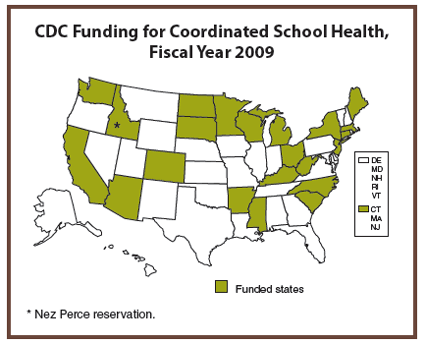 |
|
 |
 |
 |
SCHOOL HEALTH PROGRAMS
Improving the Health of Our Nation’s Youth
At A Glance
2009

Schools: The Right Place for a Healthy Start
Establishing healthy behaviors during childhood and maintaining them is
easier and more effective than trying to change unhealthy behaviors during
adulthood. Schools play a critical role in promoting the health and safety
of young people and helping them establish lifelong healthy behavior
patterns. Each day, the nation’s 126,000 schools provide
- An opportunity for 56 million students to learn about health and
practice the skills that promote healthy behaviors.
- A place for students to practice healthy behaviors such as eating
healthy foods and participating in physical activity.
Risk Behaviors Are Established Early in Life
Six types of health risk behaviors contribute to the leading causes of
death, disability, and social problems in the United States: tobacco use;
unhealthy eating; inadequate physical activity; alcohol and other drug use;
sexual behaviors that may result in HIV infection, other sexually
transmitted diseases (STDs), and unintended pregnancy; and behaviors that
contribute to unintentional injury and violence. These behaviors are often
established during childhood or adolescence, persist into adulthood, and are
preventable.
School health programs should focus on those health risk behavior areas,
as well as other key health issues such as asthma and mental health, that
have a great impact on the overall health and well-being of students.
Effective School Health Programs Reduce Risk Behaviors and Improve
Learning
Research has shown that school health programs can reduce the prevalence
of health risk behaviors among young people and have a positive effect on
academic performance. The following findings demonstrate the effectiveness
of school health programs:
- A North Carolina youth antismoking campaign increased the percentage
of school districts in the state that adopted 100% tobacco-free school (TFS)
policies from 5% in 2000 to 75% in 2007. Building on that momentum, the
state legislature bolstered the campaign by passing legislation in 2007
mandating statewide TFS compliance. By July 2008, all of North
Carolina’s 115 school districts were 100% tobacco free.
|
Health
Risks Faced by Young People
- 1 in 5 high
school students in the United States are current smokers.
- Almost 80% of
high school students do not eat the recommended 5 servings
of fruits and vegetables a day. Only 1 in 3
participates in daily physical education classes.
- 1 in 3 children
and adolescents are overweight or obese.
- About one-third
of girls in the United States get pregnant before age 20.
- Each year, there
are approximately 19 million new STD cases in the United
States, almost half of which are among youth and young
adults aged 15–24 years.
- In 2006, an
estimated 34% (19,200) of all new HIV infections occurred
among young people aged 13–29 years.
- Young people
miss nearly 13 million school days a year because of asthma.
- 30% of deaths
among young people aged 10–24 years are due to motor-vehicle
crashes.
- 1 in 5 young
people aged 9–17 years have symptoms of mental health
problems that cause some level of impairment in a given
year.
|
|
- Students participating in a culturally appropriate school-based
diabetes prevention program in San Antonio, Texas, had significantly
decreased fasting glucose levels, increased fitness scores, and
increased dietary fiber intake compared with students who did not
participate in the program.
- Inner-city children in Baltimore, Maryland, who participated in a
school breakfast program increased their nutrient intake and were more
likely to improve their academic and psychosocial functioning than those
who did not participate in the program.
- Implementation of a multicomponent, school-based physical activity
and nutrition program slowed the increase in rates of obesity and
overweight among low-income Hispanic elementary students in El Paso,
Texas. Specifically, the increase in rates of obesity and overweight for
students in program schools (girls [2%], boys [1%]) was less than that
of students not in program schools (girls [13%], boys [9%]).
- Girls enrolled in South Carolina high schools who participated in a
multicomponent, school-based physical activity program increased their
participation in regular vigorous physical activity compared with girls
who did not receive the program. The program included tailored physical
and health education classes, role modeling by faculty and staff,
increased communication about physical activity, promotion of physical
activity by the school nurse, and family- and community-based
activities.
- An evaluation of a school-based HIV, STD, and unintended pregnancy
prevention intervention for high school students found that for every
dollar invested in the program, about $2.65 in total medical and social
costs were saved. These costs were determined based on the estimated
cases of HIV, chlamydia, gonorrhea, pelvic inflammatory disease, and
number of pregnancies prevented by positive behaviors adopted by
students as a result of the program.
CDC’s Response: Advance and Support School Health Programs
Coordinated School Health
Schools by themselves cannot solve the nation’s most serious health and
social problems. However, schools have a critical role to play in
partnership with community agencies and organizations to improve the health
and well-being of young people. One approach recommended by CDC is
coordinated school health (CSH). CSH brings together school administrators,
teachers, other staff, students, families, and community members to assess
health needs; set priorities; and plan, implement, and evaluate school
health activities.
CSH typically integrates health promotion efforts across eight
interrelated components that already exist to some extent in most schools.
These components include the following:
- Health Education
- Physical Education
- Health Services
- Nutrition Services
- Counseling, Social, and Psychological Services
- Healthy and Safe School Environments
- Staff Wellness
- Family/Community Involvement
CDC has consistently used an eight-component CSH model as an organizing
framework for its school health guidelines, surveillance systems,
recommendations for promising practices, and research application tools.
Many states and cities have embraced this model to guide their school health
efforts.
CDC’s Leadership
CDC funds education and health agencies in 22 states and 1 tribal
government to help schools implement CSH, with an emphasis on promoting
physical activity, healthy eating, and a tobacco-free lifestyle. CDC also
funds 50 state education agencies (including the District of Columbia), 1
tribal government, 6 territorial education agencies, and 16 large urban
school districts for school-based HIV prevention. Ten large urban school
districts receive CDC support for school-based asthma management programs.
To help states, districts, and schools improve school health programs,
CDC has developed science-based guidelines, strategies, and tools and
identified priority actions that states can take to support CSH locally.
Specifically, CDC supports the efforts of state, territorial, and local
agencies to implement science-based, cost-effective programs by undertaking
the following:
- Monitoring health risk behaviors and school health policies and
programs through the Youth Risk Behavior Surveillance System (YRBSS),
the School Health Policies and Programs Study (SHPPS), and School Health
Profiles.
- YRBSS consists of national, state, and large urban school
district surveys of representative samples of high school students.
Conducted every 2 years, these surveys monitor health risk behaviors
among young people so that health and education agencies can more
effectively target and improve programs.
- Conducted every 6 years, SHPPS is the most comprehensive
study of U.S. school health policies and programs. SHPPS assesses
the characteristics of school health policies and programs at the
state, district, school, and classroom levels nationwide across all
eight CSH components.
- Profiles, a biennial survey conducted by state and local
education and health agencies, provides data on school health
policies and practices in states and large urban school districts.
- Analyzing research findings to develop guidelines for addressing
priority health risk behaviors among students and creating tools to help
schools implement these guidelines. Examples include the following:
- Guidelines for School Health Programs to Prevent Tobacco Use
and Addiction was developed in collaboration with tobacco-use
prevention experts across the nation and identifies the most
effective policies and practices schools can implement to prevent
tobacco use and addiction among young people and create a
tobacco-free environment in which students can learn.
- School Health Index (SHI): A Self-Assessment and Planning
Guide helps schools implement evidence-based policies and
practices that promote safe and healthy behaviors. SHI provides the
tools and resources needed to assist stakeholders (e.g., teachers,
parents, students, and community members) in assessing health
policies and programs and developing an improvement plan based on
assessment results.
- Physical Education Curriculum Analysis Tool (PECAT) helps
school districts conduct a clear, complete, and consistent analysis
of physical education curricula, based upon national physical
education standards. Results from the analysis can help school
districts provide quality physical education in schools.
- Expanding knowledge of how to address youth health risks through
research on determinants of health risk behaviors and evaluations of
innovative school-based approaches to health promotion.
- Supporting the efforts of 23 national nongovernmental organizations
to build the capacity of states, territories, tribal governments, and
cities to implement effective school health programs. Some of these
organizations also are funded to help community-based organizations
implement science-based programs to help youth in high-risk situations
(e.g., those in juvenile justice facilities or not enrolled in school)
avoid critical health risks, such as HIV infection.

[A text description of this map is also available.]
Back to top
Success Stories
Wisconsin: Building Healthier Schools to Foster Healthier Students
The nation’s major chronic disease killers—heart disease and stroke,
cancer, and diabetes—are often caused by risk behaviors such as physical
inactivity, unhealthy eating, and tobacco use. The 2007 Youth Risk Behavior
Survey (YRBS) indicated that among Wisconsin’s high school students
- 49% have ever smoked and 20.5% were current smokers.
- 11% were obese.
- Less than 18% ate fruits and vegetables at least 5 times a day.
Wisconsin’s Coordinated School Health Program, supported in part through
CDC’s Division of Adolescent and School Health, has developed or supported
initiatives to reduce tobacco use and increase physical activity and healthy
eating among students, their families, and school staff. Efforts include the
following:
- The School Tobacco Prevention Program is increasing the use of CDC’s
tobacco-use prevention guidelines in Wisconsin schools, implementing
evidence-based educational programs, and making cessation services more
available to youth.
- The Movin’ and Munchin’ Schools campaign is helping
Wisconsin’s young people, families, and school staff develop lifetime
skills and habits of physical activity and healthy nutritional choices.
- The Governor’s School Health Award is recognizing schools with
policies, programs, organizational capacity, and parental and community
involvement to support and promote healthy lifestyles and staff
wellness.
Major accomplishments of the Wisconsin program include the following:
- The smoking rate among high school students decreased from 38.1% in
1999 to 20.5% in 2007.
- During the Movin’ and Munchin’ Schools campaign, 101,641
students, 39,143 parents, and 9,265 staff reported increases in physical
activity and fruit and vegetable consumption.
- Wisconsin was one of 15 states selected as a National Governors
Association Healthy Kids, Healthy America grantee for 2007–2008 to
advance programs to help prevent childhood obesity.
North Carolina: Making Tobacco Free Schools a Reality in a
Tobacco-Growing State
Each year, cigarette smoking accounts for approximately one of every five
deaths in the United States. For high school students in North Carolina, the
2007 YRBS results indicated that about 22% smoked cigarettes. Among those
students, more than half had tried to quit smoking cigarettes during the 12
months before the survey.
Tackling the smoking problem among youth has long presented a significant
challenge for both the public health and public school sectors. The North
Carolina Prevention and Control Branch, Health and Wellness Trust Fund
Commission, and the state’s Tobacco-Free Schools (TFS) initiative have made
significant strides in addressing this major health concern. Partnerships
and cross-agency efforts at multiple levels were key to North Carolina’s
progress in preventing smoking among its youth.
The North Carolina Healthy Schools Initiative, funded in part through
CDC’s Division of Adolescent and School Health, supported development and
implementation of school policies to advance the state’s youth antismoking
campaign. Individuals and teams working with the Healthy Schools Initiative
did the following:
- Helped develop and review model language for TFS policies.
- Sponsored regional workshops to train principals, other
administrators, school nurses, and Safe and Drug-Free Schools staff in
ways to attain compliance with TFS policies.
- Conducted forums with school superintendents, principals, and school
board members to encourage them to join the growing ranks of other
districts endorsing TFS policies.
The percentage of school districts in North Carolina adopting 100% TFS
policies increased from 5% in 2000 to 75% in 2007. Building on that
momentum, the state legislature further bolstered the campaign by passing a
law in 2007 mandating statewide TFS compliance. By July 2008, all 115 of
North Carolina’s school districts were 100% tobacco-free.
California: Investment in Training for School Leaders Yields Huge
Benefits for Students
In 2007, less than 30% of California students in grades 5, 7, and 9 met
the fitness standards for the state’s FITNESSGRAM, an annual physical
fitness test given to students in selected grades in the state’s public
schools. In recent years, many of California’s school districts have seen
substantial reductions in resources available for supporting efforts to
improve student health. Motivated by the growing concerns over student
health and fitness levels, school health leaders in California decided to
enhance their knowledge and skills in managing and promoting school health
programs.
Funded by CDC’s Division of Adolescent and School Health to promote
coordinated school health (CSH), the California Department of Education’s
School Health Connections Program collaborated with the state Department of
Health Services to conduct state- and local-level leadership institutes.
These were modeled after the American Cancer Society’s (ACS) National School
Health Leadership Institutes and were conducted in partnership with the
California Division of the ACS, which also provided local staff and
financial support.
Since 2005, more than 40 district teams in California have participated
in School Health Leadership Institutes, learning how to build, promote, and
sustain school health programs. Successful activities include the following:
- The El Dorado High School District obtained a Carol M. White Award
for almost $100,000 for 3 years to improve physical education programs.
- The Los Angeles Unified School District created a CSH District
Council, launched CSH pilot programs, formally adopted a Policy and
Blueprint on Wellness, and created the District’s first comprehensive
program to address childhood obesity and diabetes.

Back to top
Related Materials
Back to top
|
For more information please contact
Centers for Disease
Control and Prevention
National Center for Chronic Disease Prevention and Health Promotion
4770 Buford Highway NE, Mail Stop K–29, Atlanta, GA 30341-3717
Telephone: 800-CDC-INFO (232-4636) • TTY: 888-232-6348
E-mail: cdcinfo@cdc.gov • Web:
http://www.cdc.gov/healthyyouth
|
|
 One or more documents on this Web page is available in Portable Document Format
(PDF). You will need Acrobat
Reader (a free application) to view and print these documents.
One or more documents on this Web page is available in Portable Document Format
(PDF). You will need Acrobat
Reader (a free application) to view and print these documents.
Page last reviewed: February 11, 2009
Page last modified: February 11, 2009
Content source: National Center for
Chronic Disease Prevention and Health Promotion
|
 |

![]() One or more documents on this Web page is available in Portable Document Format
(PDF). You will need Acrobat
Reader (a free application) to view and print these documents.
One or more documents on this Web page is available in Portable Document Format
(PDF). You will need Acrobat
Reader (a free application) to view and print these documents.